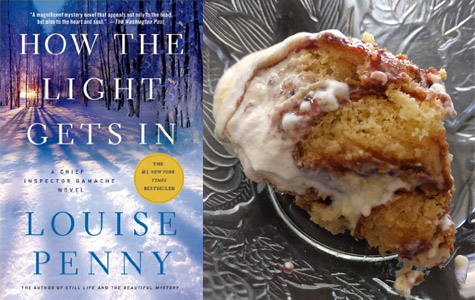
This was the first book I ever read in the Inspector Gamache series—back when it first came out—and, boy, was that a mistake! I only realized this upon reading the preceding eight novels, then re-reading this one. I missed so much by starting here first!
Back when How the Light Gets In first came out, I wanted to see what all the fuss over Louise Penny was about, so I read it and thought it was good, solid storytelling. But now that I’ve caught up with the entire series, I can see that this novel is a work of brilliance—a terrific capstone for all the events that led up to it. Sure there are still threads unresolved, material for future books, but so much of the loving detail that Ms. Penny has woven into the first eight parts of the series come together here to form a story that rewards her loyal readers again and again with callbacks that both delight and resonate with deeper meaning. I really did myself a disservice by starting here instead of at the beginning.
This ninth book of the series sees Chief Inspector Armand Gamache of the Surêté du Québec in the most vulnerable position of his career to date. His homicide department has been stripped of his loyal agents—who’ve been transferred out willingly or otherwise—leaving him with only his trusted second-in-command, Inspector Isabelle Lacoste, and a motley crew of agents of dubious moral character.
After the events of The Beautiful Mystery, his previous right-hand man, Inspector Jean Guy Beauvoir, has chosen to stay with Gamache’s immediate superior, Superintendent Sylvain Francoeur, who encourages Beauvoir’s most self-destructive behaviors. With little professional support, and despite his excellent track record, it looks almost certain that Gamache will be forced into retirement soon.
It thus comes as almost a relief to him when Myrna, owner of the bookstore in Three Pines, asks him to investigate the disappearance of an elderly friend. When he finds the friend murdered in her Montreal home, he begins an investigation that digs deeply into Canada’s past, even as events in the present portend disaster for the country.
It’s almost ironic that the single recipe chosen to accompany this thoughtful, complex book is something named for an inconsequential:
Trifle
*Makes 8 servings
Ingredients
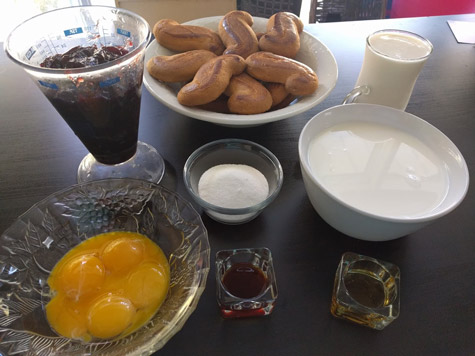
For The Custard
5 egg yolks
2½ cups (600 ml) whole milk
¹⁄³ cup (67 g) granulated sugar
2 teaspoons pure vanilla extract
To Assemble the Trifle
1 cup (250 ml) very cold heavy (whipping) cream
1½ cups (432 g) raspberry jam
1 tablespoon brandy, Cointreau, or other orange liqueur
2½ to 3 packages (3.5 oz/100 g each) ladyfingers (see Notes)
Instructions
1. Make the custard: Put the egg yolks in a heatproof bowl. Heat the milk and sugar in a 2-quart/2-liter heavy saucepan, stirring to dissolve the sugar, until bubbles form around the edge. Gently and gradually, whisk the hot milk into the egg yolks, then pour everything back into the saucepan. Cook over medium heat, scraping the bottom and sides with a heatproof spatula to prevent sticking until the custard is steaming and thick enough to lightly coat the spatula. If you have an instant-read thermometer, the custard is ready when the temperature registers 185°F/85°C. Strain the custard into a bowl and stir in the vanilla. Cover with a piece of plastic wrap pressed directly on the surface of the custard to prevent a skin from forming. Refrigerate until cool or thoroughly chilled, 2 to 4 hours.
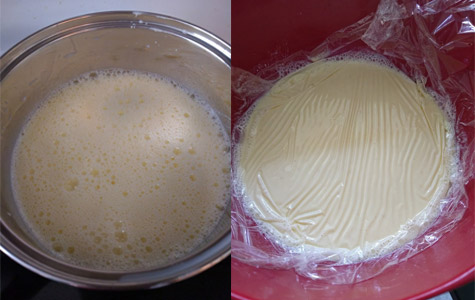
2. Assemble the trifle: With a whisk or electric hand mixer, beat the heavy cream until it forms soft peaks. Set aside. In a wide, shallow bowl, stir together the jam and brandy. Have at hand an 8×11-inch (20×28-cm), or other more decorative glass 2-quart (2-liter) dish. This will be a little messy: working with your hands, turn each ladyfinger in the jam mixture and line the bottom of the dish. The ladyfingers may have to run in different directions or you may have to snap them in half to get the right fit to cover the bottom of the dish snugly. Pour about half the custard over the ladyfingers. Spoon about half the whipped cream over the ladyfingers and spread it out into a more or less even layer. (This is a rustic dish, don’t worry if some of the jam gets mixed in with the custard or whipped cream or is smeared against the inside of the glass dish—that is part of the charm.) Repeat with another layer of jam-dipped ladyfingers, custard, and whipped cream.
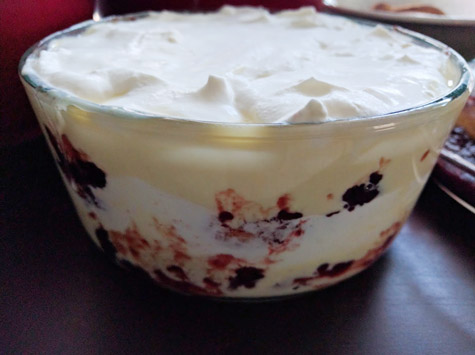
3. Cover the dish tightly with plastic wrap and refrigerate until the ladyfingers have soaked up all the custard and the trifle is soft but spoonable, 12 to 24 hours. Serve chilled, spooning the trifle into coupes or onto dessert plates.
Notes:
- The ladyfingers should be very dry, (not the spongy type of cookie), typically packed about 20 per box. If you find your ladyfingers are soft rather than dry, simply spread them out on a cooling rack or baking sheet and let them dry out overnight.
- The trifle needs at least 12 hours and up to a full day for the ladyfingers to soak up the custard and for the trifle to firm up. That will give you a trifle with a spoonable yet still soft texture.
- While the above recipe calls for an 8×11-inch (20 × 28-cm) dish, any shape dish with close to a 2-quart (2-liter) capacity will do. Glass is better—you can see the pretty layers and jam from the sides.
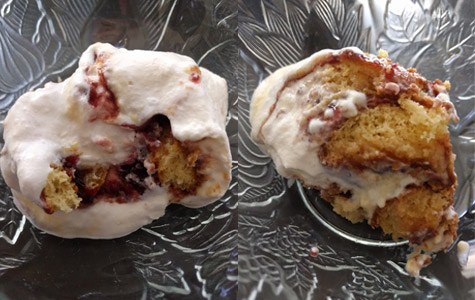
I had a bit of difficulty finding honest-to-goodness ladyfingers, so I used a breakfast treat substitute that tasted very similar despite having a markedly different shape. They were a little sweeter than regular ladyfingers, though, which made the end product taste a bit too sugary for me. But if you like your sweets, then this is definitely the dessert for you!
Now, I’d never made a jam trifle before, though I do have experience constructing both fresh berry trifles and jelly trifles. The jam trifle is definitely a heavier dessert than either of those, but is a variation perfect for colder weather, as I typically think of the lighter trifles as a warm weather dessert. I actually very much enjoyed the delicious tartness of the red raspberry jam in this dish, which cut through the sweetness quite well.
Next week, I continue the streak of dessert-making with a chocolate and raspberry mousse! I also get to dive into the next Inspector Gamache novel, all agog to see what happens after the climactic events of this one! Tell me your thoughts and how you’re doing as you cook along with me from The Nature of the Feast, Louise Penny’s free cookbook accompaniment to her bestselling Inspector Gamache series.
To learn more or order a copy, visit:
opens in a new window![]() opens in a new window
opens in a new window![]()
Doreen Sheridan is a freelance writer living in Washington, D.C. She
microblogs on Twitter @dvaleris.
Read all posts by Doreen Sheridan for Criminal Element.

I love Trifle. This is a terrific recipe. I linked on Facebook so everyone could try this!!
Thanks, Terrie! I need to try this with a less sweet biscuit next time, as I was unashamedly gobbling up the leftover jam-brandy mixture while assembling it: so good!